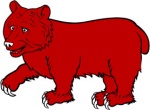Bear
Bears are quadruped mammals, of the family Ursidae. They are carnivores as opposed to herbivores, but in practice will eat anything nutritious.
- Male: boar
- Female: dam
- Juvenile: cub
- Collective noun: sleuth
According to Wikipaedia:
- "Common characteristics of bears include a short tail, excellent senses of smell and hearing, five un-retractable claws, and long, dense, shaggy fur.
- "Bears have a large body with powerful limbs. They are capable of standing up on their hind legs. They have broad paws, long snouts, and round ears. Their teeth are used for defense and tools and depend on the diet of the bear. Their claws are used for ripping, digging, and catching."
In period, in Europe, the principal bear was the brown bear, which was, throughout period, slowly being driven back into ever-more restricted ranges, having formerly inhabited the continent widely. Man hunted the bear, with dogs, both to reduce its predations on their cultivated lands, and also for meat and fur.
There is some evidence for bear-worship prior to period, and several cities (most notably Berne and Berlin) appear to have been named in commemoration of the beast. The Latin ursus links to the Greek arktos and the Celtic artos/arthus, to offer one rationale for the name Arthur for a legendary warleader (qv King Arthur).
Regrettably the stuffed bear (Ursus refertus) has left no imprint upon medieval history, but it is almost inevitable that there will have been some, given that they have survived, relatively unchanged (and with very wide ranges), to the modern era.
Bears in the SCA
So far as is known, no bears have sought to join the SCA. Were any to do so, it is likely that they would face certain difficulties in interacting with other members.
Bears cannot register names or devices, nor can they become members.
